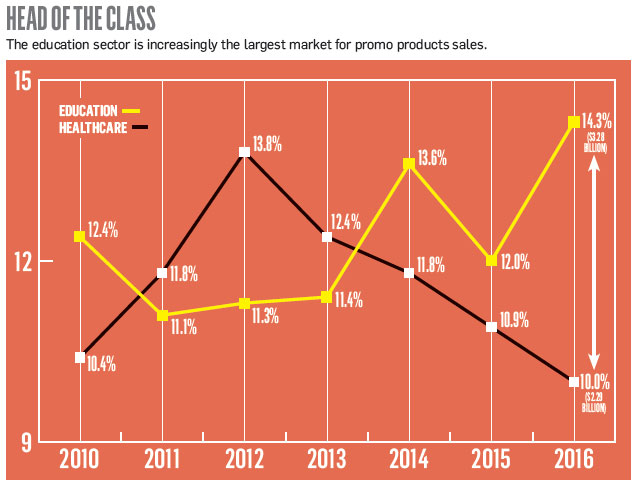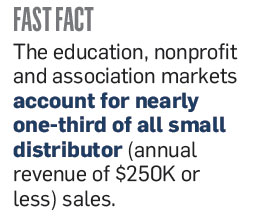Awards July 19, 2017
How to Cash In On the Education Sector
Distributors can capitalize on the promo industry’s top market by taking a timely approach.
The education sector accounted for $3.28 billion, or 14.3% of promo product sales in 2016 – continuing its run as the largest market in terms of distributor revenue. How are distributors succeeding in this lucrative, but competitive space?
>>Back to the State of the Industry 2017
Ohio-based Rokkitwear (asi/311331), which serves K-12 schools, follows this formula: provide customers with super-quick and easy online ordering, then deliver branded items right to their doorsteps. If this model sounds familiar, that’s because it is.
“Since Amazon represents such a huge share of the market, it’s appropriate to look at them and say, ‘How can we mirror some of those capabilities?’” says Chris Berger, owner at Rokkitwear, which does 100% of its business in the education market. “Amazon has conditioned people to expect product within a few days of purchasing online. They want choice, convenience and quick delivery, and that’s what we give our customers – no minimums, and most orders ship within three business days.”
Traditionally, colleges and universities are the largest sources of revenue for distributors selling into the education market. However, high schools are increasingly spending money on school spirit products and events in an attempt to build their brands and recruit and retain students.
“High school is the new college when it comes to licensed promotional merchandise,” says Rick Mouty, president of Profill Holdings. “For the bigger high schools, it pays to have their branded gear available for sale outside the traditional on-premise spirit shop.”
Schools are notoriously difficult, though, when it comes to determining buyers because of the administration and faculty layout. Kelly Groene, owner of GRO Business Solutions (asi/214659), has a foot in: she’s also a career teacher.

“I have a lot of colleagues in the schools, so over the years I have built those relationships and I know my clientele very well,” Groene says.
Groene has seen an increase in statewide safety and suicide prevention programs recently, and has witnessed the ability of promotional items to support the community through tough times. “Wyoming has had one of the biggest economic downturns in the past year in addition to one of the highest suicide rates among teens, so with the cuts in school district funds, community businesses are buying promo products for education,” says Groene. “Local businesses are chipping in for campaigns and adding their logos as both sponsorship and advertisement.”
As in any industry, knowing the true needs of your customers is paramount, which also means knowing the best times to approach them with buying opportunities and where to find the best channels.
Glen McCandless spent much of his career in education sales and marketing positions for Apple. He founded Focus Marketing in 1995 with the goal of providing the best business development services to the education industry. “Timing is unforgiving in the education market,” says McCandless. “Everything marches to the academic calendar, which has about a four-week swing depending on where you are regionally, and the fiscal calendar, which in most cases is a July 1 start.”
Two key buying times for schools are before the school year starts in late August or early September, when they’re looking for products to support curriculum or activities, and just prior to the second semester after the winter holiday, when buyers are setting the remaining year’s budget or planning for the following school year. “This doesn’t mean buyers aren’t receptive other times of year, but you have to know when the money is available,” McCandless says.
Perhaps a less obvious opportunity surrounds the annual conferences and trade shows catering to educational establishments. According to McCandless, the education market holds more conferences per capita than any other industry.

“There’s a conference for suppliers of school furniture, appliances, printed goods, paint, anything you can think of,” he says. “The smart promo companies are realizing that this is great leverage – it’s not only a market itself, it’s a channel to reach the market.”
One good target: the National Association for the Education of Young Children annual conference is held in seven states each fall and attracts more than 40,000 educators and thousands of exhibitors, all giving away promo products. “Educators are scooping these products up and will often keep them for buying decisions later in the year,” McCandless says.
